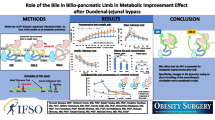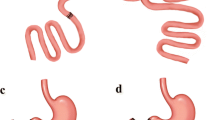Abstract
Background
Bile acids (BAs) are important in the metabolic effects of bariatric surgery. Most BAs are reabsorbed in the ileum and recycled back to the liver. We have reported that this enterohepatic circulation was shortened by duodenal-jejunal bypass (DJB), and the biliopancreatic (BP)-limb plays an important role in reabsorption of BAs. However, the mechanism of BA reabsorption in BP-limb remains uncertain. We aimed to investigate the mechanisms of BA reabsorption after DJB, especially focusing on carrier-mediated transport of BAs and the impact of the presence or absence of lipids on BA reabsorption.
Methods
Otsuka-Long-Evans-Tokushima fatty rats or Sprague-Dawley rats were assigned to a control group and DJB group. BA levels in the divided small intestine were quantified with liquid chromatography-mass spectrometry. Labeled BA was injected and perfused with BA transporter inhibitors or mixture of lipids in the isolated BP-limb, and bile was sampled and analyzed.
Results
Conjugated BA levels in the BP-limb were significantly higher than that of the control group. BA absorption tended to decrease by the apical sodium-dependent BA transporter inhibitor and was significantly decreased by the organic anion-transporting peptide (OATP) inhibitor. BA absorption tended to increase in the absence of lipid solutions compared with that in the presence of lipid solutions.
Conclusion
We attributed the increased BA reabsorption in the BP-limb to lack of food in the BP-limb, which contains concentrated BAs and no lipids. OATP played an important role in BA reabsorption in the BP-limb. Therefore, BAs would be reabsorbed in different manners after DJB.





Similar content being viewed by others
References
Rubino F, Nathan DM, Eckel RH, et al. Metabolic surgery in the treatment algorithm for type 2 diabetes: a joint statement by international diabetes organizations. Obes Surg. 2017;27:2–21.
Buchwald H, Estok R, Fahrbach K, et al. Weight and type 2 diabetes after bariatric surgery: systematic review and meta-analysis. Am J Med. 2009;122:248–256.e5.
Salminen P, Helmiö M, Ovaska J, et al. Effect of laparoscopic sleeve gastrectomy vs laparoscopic Roux-en-Y gastric bypass on weight loss at 5 years among patients with morbid obesity: the SLEEVEPASS randomized clinical trial. JAMA. 2018;319:241–54.
Lee WJ, Almulaifi AM, Tsou JJ, et al. Duodenal-jejunal bypass with sleeve gastrectomy versus the sleeve gastrectomy procedure alone: the role of duodenal exclusion. Surg Obes Relat Dis. 2015;11:765–70.
Seki Y, Kasama K, Umezawa A, et al. Laparoscopic sleeve gastrectomy with duodenojejunal bypass for type 2 diabetes mellitus. Obes Surg. 2016;26:2035–44.
Naitoh T, Kasama K, Seki Y, et al. Efficacy of sleeve gastrectomy with duodenal-Jejunal bypass for the treatment of obese severe diabetes patients in Japan: a retrospective multicenter study. Obes Surg. 2018;28:497–505.
Imoto H, Shibata C, Ikezawa F, et al. Effects of duodeno-jejunal bypass on glucose metabolism in obese rats with type 2 diabetes. Surg Today. 2014;44:340–8.
Miyachi T, Nagao M, Shibata C, et al. Biliopancreatic limb plays an important role in metabolic improvement after duodenal-jejunal bypass in a rat model of diabetes. Surgery. 2016;159:1360–71.
Breen DM, Rasmussen BA, Kokorovic A, et al. Jejunal nutrient sensing is required for duodenal-jejunal bypass surgery to rapidly lower glucose concentrations in uncontrolled diabetes. Nat Med. 2012;18:950–5.
Ryan KK, Tremaroli V, Clemmensen C, et al. FXR is a molecular target for the effects of vertical sleeve gastrectomy. Nature. 2014;509:183–8.
Ise I, Tanaka N, Imoto H, et al. Changes in enterohepatic circulation after duodenal-jejunal bypass and reabsorption of bile acids in the bilio-pancreatic limb. Obes Surg. 2019;29:1901–10.
Dawson PA, Haywood J, Craddock AL, et al. Targeted deletion of the ileal bile acid transporter eliminates enterohepatic cycling of bile acids in mice. J Biol Chem. 2003;278:33920–7.
Dawson PA, Hubbert M, Haywood J, et al. The heteromeric organic solute transporter alpha-beta, Ostalpha-Ostbeta, is an ileal basolateral bile acid transporter. J Biol Chem. 2005;280:6960–8.
Amelsberg A, Schteingart CD, Ton-Nu HT, et al. Carrier-mediated jejunal absorption of conjugated bile acids in the guinea pig. Gastroenterology. 1996;110:1098–106.
Amelsberg A, Jochims C, Richter CP, et al. Evidence for an anion exchange mechanism for uptake of conjugated bile acid from the rat jejunum. Am J Phys. 1999;276:G737–42.
Walters HC, Craddock AL, Fusegawa H, et al. Expression, transport properties, and chromosomal location of organic anion transporter subtype 3. Am J Physiol Gastrointest Liver Physiol. 2000;279:G1188–200.
Wilson FA, Dietschy JM. Characterization of bile acid absorption across the unstirred water layer and brush border of the rat jejunum. J Clin Invest. 1972;51:3015–25.
Kawano K, Hirashima T, Mori S, et al. Spontaneous long-term hyperglycemic rat with diabetic complications. Otsuka Long-Evans Tokushima fatty (OLETF) strain. Diabetes. 1992;41:1422–8.
Kawano K, Hirashima T, Mori S, et al. OLETF (Otsuka Long-Evans Tokushima fatty) rat: a new NIDDM rat strain. Diabetes Res Clin Pract. 1994;24(Suppl):S317–20.
Funakoshi A, Miyasaka K, Jimi A, et al. Little or no expression of the cholecystokinin-A receptor gene in the pancreas of diabetic rats (Otsuka Long-Evans Tokushima fatty = OLETF rats). Biochem Biophys Res Commun. 1994;199:482–8.
Moran TH, Katz LF, Plata-Salaman CR, et al. Disordered food intake and obesity in rats lacking cholecystokinin A receptors. Am J Phys. 1998;274:R618–25.
Panchal SK, Brown L. Rodent models for metabolic syndrome research. J Biomed Biotechnol. 2011;2011:351982.
Tsuchiya T, Naitoh T, Nagao M, et al. Increased bile acid signals after duodenal-jejunal bypass improve non-alcoholic steatohepatitis (NASH) in a rodent model of diet-induced NASH. Obes Surg. 2018;28:1643–52.
Aldini R, Montagnani M, Roda A, et al. Intestinal absorption of bile acids in the rabbit: different transport rates in jejunum and ileum. Gastroenterology. 1996;110:459–68.
Marcus SN, Schteingart CD, Marquez ML, et al. Active absorption of conjugated bile acids in vivo. Kinetic parameters and molecular specificity of the ileal transport system in the rat. Gastroenterology. 1991;100:212–21.
Sugawara T, Kushiro M, Zhang H, et al. Lysophosphatidylcholine enhances carotenoid uptake from mixed micelles by Caco-2 human intestinal cells. J Nutr. 2001;131:2921–7.
Morita SY, Kobayashi A, Takanezawa Y, et al. Bile salt-dependent efflux of cellular phospholipids mediated by ATP binding cassette protein B4. Hepatology. 2007;46:188–99.
Ikeda Y, Morita SY, Terada T. Cholesterol attenuates cytoprotective effects of phosphatidylcholine against bile salts. Sci Rep. 2017;7:306.
Bhutta HY, Rajpal N, White W, et al. Effect of Roux-en-Y gastric bypass surgery on bile acid metabolism in normal and obese diabetic rats. PLoS One. 2015;10:e0122273.
Flynn CR, Albaugh VL, Cai S, et al. Bile diversion to the distal small intestine has comparable metabolic benefits to bariatric surgery. Nat Commun. 2015;6:7715.
Kohli R, Setchell KD, Kirby M, et al. A surgical model in male obese rats uncovers protective effects of bile acids post-bariatric surgery. Endocrinology. 2013;154:2341–51.
Ikezawa F, Shibata C, Kikuchi D, et al. Effects of ileal interposition on glucose metabolism in obese rats with diabetes. Surgery. 2012;151:822–30.
McClintock C, Shiau YF. Jejunum is more important than terminal ileum for taurocholate absorption in rats. Am J Phys. 1983;244:G507–14.
Lewis MC, Root C. In vivo transport kinetics and distribution of taurocholate by rat ileum and jejunum. Am J Phys. 1990;259:G233–8.
van de Steeg E, Wagenaar E, van der Kruijssen CM, et al. Organic anion transporting polypeptide 1a/1b-knockout mice provide insights into hepatic handling of bilirubin, bile acids, and drugs. J Clin Invest. 2010;120:2942–52.
van de Steeg E, van Esch A, Wagenaar E, et al. High impact of Oatp1a/1b transporters on in vivo disposition of the hydrophobic anticancer drug paclitaxel. Clin Cancer Res. 2011;17:294–301.
Gong L, Aranibar N, Han YH, et al. Characterization of organic anion-transporting polypeptide (Oatp) 1a1 and 1a4 null mice reveals altered transport function and urinary metabolomic profiles. Toxicol Sci. 2011;122:587–97.
Mika A, Kaska L, Proczko-Stepaniak M, et al. Evidence that the length of bile loop determines serum bile acid concentration and glycemic control after bariatric surgery. Obes Surg. 2018;28:3405–14.
Risstad H, Kristinsson JA, Fagerland MW, et al. Bile acid profiles over 5 years after gastric bypass and duodenal switch: results from a randomized clinical trial. Surg Obes Relat Dis. 2017;13:1544–53.
Boerboom A, Homan J, Aarts E, et al. A long biliopancreatic and short alimentary limb results in more weight loss in revisional RYGB surgery. Outcomes of the randomized controlled ELEGANCE REDO trial. Surg Obes Relat Dis. 2019;15:60–9.
Nergaard BJ, Leifsson BG, Hedenbro J, et al. Gastric bypass with long alimentary limb or long pancreato-biliary limb—long-term results on weight loss, resolution of co-morbidities and metabolic parameters. Obes Surg. 2014;24:1595–602.
Acknowledgments
The authors thank Ms. Emiko Shibuya for the technical assistance and the staff of the Institute for Animal Experimentation, Graduate School of Medicine, Tohoku University, for assistance with animal husbandry and care.
Funding
This study was supported by the grant-in-aid for scientific research from the Japan Society for the Promotion of Science (Grant Nos.: 17K10619, 17K10575) and Gonryo Medical Scholarship Promotion Association (Anzai Memorial Prize for Diabetes Research).
Author information
Authors and Affiliations
Corresponding author
Ethics declarations
Conflict of Interest
The authors declare that there is no conflict of interest.
Statement of Animal Rights
All procedures in this study were approved by ethics committee for animal research of our institute.
Additional information
Publisher’s Note
Springer Nature remains neutral with regard to jurisdictional claims in published maps and institutional affiliations.
Rights and permissions
About this article
Cite this article
Ueno, T., Tanaka, N., Imoto, H. et al. Mechanism of Bile Acid Reabsorption in the Biliopancreatic Limb After Duodenal-Jejunal Bypass in Rats. OBES SURG 30, 2528–2537 (2020). https://doi.org/10.1007/s11695-020-04506-3
Published:
Issue Date:
DOI: https://doi.org/10.1007/s11695-020-04506-3




